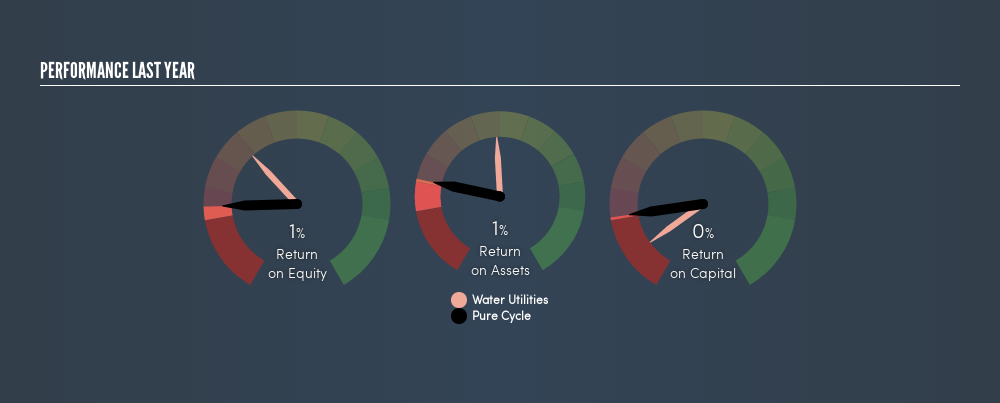- United States
- /
- Water Utilities
- /
- NasdaqCM:PCYO
How Do Pure Cycle Corporation’s (NASDAQ:PCYO) Returns Compare To Its Industry?

Today we are going to look at Pure Cycle Corporation (NASDAQ:PCYO) to see whether it might be an attractive investment prospect. Specifically, we'll consider its Return On Capital Employed (ROCE), since that will give us an insight into how efficiently the business can generate profits from the capital it requires.
First of all, we'll work out how to calculate ROCE. Next, we'll compare it to others in its industry. And finally, we'll look at how its current liabilities are impacting its ROCE.
Return On Capital Employed (ROCE): What is it?
ROCE measures the amount of pre-tax profits a company can generate from the capital employed in its business. In general, businesses with a higher ROCE are usually better quality. In brief, it is a useful tool, but it is not without drawbacks. Author Edwin Whiting says to be careful when comparing the ROCE of different businesses, since 'No two businesses are exactly alike.'
So, How Do We Calculate ROCE?
The formula for calculating the return on capital employed is:
Return on Capital Employed = Earnings Before Interest and Tax (EBIT) ÷ (Total Assets - Current Liabilities)
Or for Pure Cycle:
0.0021 = US$149k ÷ (US$74m - US$3.8m) (Based on the trailing twelve months to February 2019.)
Therefore, Pure Cycle has an ROCE of 0.2%.
Check out our latest analysis for Pure Cycle
Is Pure Cycle's ROCE Good?
ROCE is commonly used for comparing the performance of similar businesses. Using our data, Pure Cycle's ROCE appears to be significantly below the 4.9% average in the Water Utilities industry. This performance could be negative if sustained, as it suggests the business may underperform its industry. Regardless of how Pure Cycle stacks up against its industry, its ROCE in absolute terms is quite low (especially compared to a bank account). There are potentially more appealing investments elsewhere.
Pure Cycle has an ROCE of 0.2%, but it didn't have an ROCE 3 years ago, since it was unprofitable. This makes us wonder if the company is improving.

It is important to remember that ROCE shows past performance, and is not necessarily predictive. Companies in cyclical industries can be difficult to understand using ROCE, as returns typically look high during boom times, and low during busts. This is because ROCE only looks at one year, instead of considering returns across a whole cycle. If Pure Cycle is cyclical, it could make sense to check out this freegraph of past earnings, revenue and cash flow.
Pure Cycle's Current Liabilities And Their Impact On Its ROCE
Current liabilities are short term bills and invoices that need to be paid in 12 months or less. Due to the way ROCE is calculated, a high level of current liabilities makes a company look as though it has less capital employed, and thus can (sometimes unfairly) boost the ROCE. To counteract this, we check if a company has high current liabilities, relative to its total assets.
Pure Cycle has total liabilities of US$3.8m and total assets of US$74m. Therefore its current liabilities are equivalent to approximately 5.1% of its total assets. Pure Cycle has a low level of current liabilities, which have a negligible impact on its already low ROCE.
What We Can Learn From Pure Cycle's ROCE
Nonetheless, there may be better places to invest your capital. Of course, you might also be able to find a better stock than Pure Cycle. So you may wish to see this freecollection of other companies that have grown earnings strongly.
If you like to buy stocks alongside management, then you might just love this freelist of companies. (Hint: insiders have been buying them).
We aim to bring you long-term focused research analysis driven by fundamental data. Note that our analysis may not factor in the latest price-sensitive company announcements or qualitative material.
If you spot an error that warrants correction, please contact the editor at editorial-team@simplywallst.com. This article by Simply Wall St is general in nature. It does not constitute a recommendation to buy or sell any stock, and does not take account of your objectives, or your financial situation. Simply Wall St has no position in the stocks mentioned. Thank you for reading.
About NasdaqCM:PCYO
Pure Cycle
Provides wholesale water and wastewater services in the United States.
Excellent balance sheet with proven track record.
Similar Companies
Market Insights
Community Narratives


